Amber Info
Back to AmberGeneral
Amber is fossil resin, produced by different conifers (mainly Pinus succinifera) about 30 – 90 million years ago. Central American amber (from Mexico and the Dominican Republic) was produced by the resins of legume trees (Hymeneae). Trees in extensive forests in some parts of the world secreted yellowish or brownish resin for a long time, sometimes even trapping animals, plants etc. Later these forests died, and were buried by sediments. The organic compounds of the resin hardened during millions of years, and were transformed into amber by oxidation and natural polymerization. Most amber is found in Cretaceous (135 Mio - 65 Mio) and Tertiary (65 Mio - 2,6 Mio) sediments. Although it is not mineralized, it is commonly considered as a gemstone.
At least since the Neolithic amber from the Baltic Sea and North Sea was collected and traded by the Teutons. They sold the finds to other tribes. Roman handimen manufactured large amber lumps into beautiful small bowls, jars etc.
Since antiquity amber was well known for its electrostatic properties: Rubbing amber with a cloth makes it electric so that bits of paper are attracted. Therefore the Greek named amber "elektron", the source for the word "electricity".
Heated amber softens, melts and can even burn. Therefore in Germanic languages it is called "Burn-Stone" (German: "Bernstein", Dutch: "Barnsteen"). Strong heating decomposes amber into a yellowish oil, then into a dark brown residue called "colophony", the basic component of amber varnish. In ancient times amber was used as candles substitute because it burns very slowly.
Collecting Amber at the Sea Shores
If a piece of wet amber on a beach doesn't reflect the sunlight it is not easy being identified as real amber. One simply cannot pick up all yellowish or brownish stones for inspection, particularly if the beach is covered with all kind of stones! Therefore here are some helpful informations for beginners:
Amber feels warm to the skin because it is organic material. That helps amber collectors to distinguish between dull amber pieces and normal stones. An even better method to identify amber is clicking the "stone" against ones teeth. Amber does not click like a mineral but feels like plastic.
At the shores of the Baltic Sea and the North Sea amber can be found after storms (if they came from the right direction), and during low-tide. Because of its specific gravity (1.05 - 1.1), slightly heavier than sea water, most amber pieces are imbedded in seaweed or lie among greyish remnants of crawfishes and shrimps as well as among small, black remnants of wood.
Collecting amber in the summer months doesn't bring satisfying results because then the water has a lower density (because of its thermal expansion). During spring, autumn and especially winter the salt water is slightly heavier so that amber swims, being caught in seaweed which then can be driven to the beach, by current or waves.
Inclusions
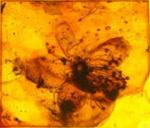 |
| Blossom in Amber * |
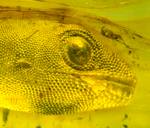 |
| Gecko in Amber * |
Dominican amber contains 1 inclusion to every 100 pieces, Baltic amber (mainly from the Baltic Sea) about 1 to every 1,000 pieces. Therefore amber with at least one inclusion is much more valuable than normal amber.
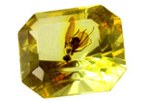 |
| Fly in Amber * |
* Photo: www.bgr.bund.de
* Photo: Wolfgang Weitschat, thanks to Aaron M. Bauer. Photo published in the Journal of Zoology, London.
* Photo: www.gemfrance.com, Dr. Laurent Sikirdji
Deposits
Europe: The shores of the Baltic Sea were the original source since prehistoric times. The first use of Baltic amber can be linked to the Neolitic. Baltic amber was found in Egyptian tombs, burial sites in the Baltic states (Estonia, Latvia, Lithuania), Germany, Poland, and the Scandinavian states. Today the major amber producing countries are Poland and especially Russia which supplies about 70% of the world's amber, and nearly all of the Baltic amber. Other European deposits are in the Czech Republic, Denmark, England, France, Germany, Italy (Sicilia), Norway, Romania, Slovakia, Sweden, Switzerland, and the Ukraine.
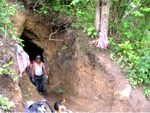 |
| Mine in Mexico * |
* Photo: www.palaeontologische-gesellschaft.de
Asia: Myanmar amber was already used by the Chinese during the Han Dynasty (206 B.C. - 220). Other deposits in Asia are in Japan, China, Malaysia and Lebanon.
Africa: Deposits in Tanzania contain material which is older than copal but younger than normal amber.
Australia / New Zealand: New Zealand "ambrite" is a transparent, yellow amber. New Zealand "Kauri copal" is very old copal material with inclusions.
Land and Sea Types
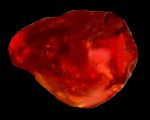 |
| Sea Amber |
Pit amber (in secondary or alluvial deposits) is mined from "blue earth", especially on Russia's Baltic coast. It is usually covered with a crust so that one cannot see the interior (quality) of a stone.
Colors and Transparency
Amber can occur in white, yellow, orange, red, brown, green, blue, and blackish. The value of a stone depends also from its transparency. The more transparent the more valuable. The transparency varies from clear to opaque. Clear, transparent amber ranges from light yellow to dark red. Semi-transparent or opaque amber can show the same colors. In the Arabic region one seems to prefer milky amber ("Butterscotch").
"Natural Amber", "Real Amber", Forgeries, Changes
"Natural Amber" ist genuine, untreated amber, as it can be found in nature. It is cutted (sometimes faceted) and polished to be used in jewelry. "Real amber" is more or less treated amber.
Animal or plant inclusions (s.a.) are very sought-after because they are rare. Therefore people tried for a long time to insert especially animals into amber or different plastics which can hardly be distinguished from genuine amber. Sometimes people include a piece of genuine amber into plastic material of the same color so that the new "amber" is larger, and of course better to sale.
Cloudy stones can be made more transparent by heating because included tiny air bubbles escape when the amber is in a viscous state. After cooling the amber is even a bit firmer. Treated in this way, it is no more "natural amber" but has to be designated as "cleared amber". Heating also changes the color: A yellowish amber turns into reddish, then brownish, depending on the temperature and heating time. Physically and chemically amber is similar to synthetic resin. Therefore melted amber can be artificially colored at will.
The sought-after but rare "spangles" (sparkling, shimmering, round cracks) can be created by quick cooling of heated amber.
Heating in modern autoclaves allows a careful fusing of amber fragments. This "pressed amber" is highly transparent, firm, and cheap. Nevertheless it is allowed calling it "genuine amber".
To distinguish "natural amber" from "genuine amber" or a forgery, several methods can be used:
1. Touching "natural amber" with a heated needle causes a typical resinous odor of coniferous forest. Heated amber doesn't smell or only a bit. Plastics smell of chemistry.
2. Plastics or copal can be identified by rubbing with acetone (resp. ethanol or acetic acid). If the material runs into the cloth or dissolves, it is most likely plastics or copal (old, hard resin, not fully hardened amber). Genuine amber is resistant even to acetone. Copal still contains natural plasticizers in contrary to amber (whose natural plasticizers have been evaporated during millions of years).
3. Because of its relative density (s.a.) amber is heavier than fresh water but lighter than concentrated salt water. Therefore amber sinks in fresh water, and swims in salt water. Glass imitations sink in both. Plastic is usually heavier than amber but swims also in salt water. In a salt solution of 120 g salt and 1 l fresh water plastics sink but amber swims.
Such methods don't work for jewelry in which amber is combined with metal or in a shop. Therefore it is important to buy amber from a trustworthy dealer.
See also the very informative website "Welcome to the World of Amber"!
⇐ Intro Page ⇐ Gemstones ⇐ Amber